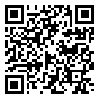Volume 28, Issue 3 (2025)
mjms 2025, 28(3): 51-57 |
Back to browse issues page
Ethics code: IR.ZAUMS.REC.1399.443
Download citation:
BibTeX | RIS | EndNote | Medlars | ProCite | Reference Manager | RefWorks
Send citation to:



BibTeX | RIS | EndNote | Medlars | ProCite | Reference Manager | RefWorks
Send citation to:
Samii Moghaddam A. Gamma Band Functional Connectivity in Olfactory-Prefrontal Pathways During Anxious States. mjms 2025; 28 (3) :51-57
URL: http://mjms.modares.ac.ir/article-30-81049-en.html
URL: http://mjms.modares.ac.ir/article-30-81049-en.html
School of Medicine, Zahedan University of Medical Sciences, Zahedan, Iran. , alisamiimoghaddam@gmail.com
Abstract: (110 Views)
Introduction: Anxiety disorders affect nearly 30% of adults worldwide and involve dysfunctional threat processing, yet the neural mechanisms remain partially understood. This study investigates the role of gamma-band oscillations in olfactory bulb (OB) and prefrontal cortex (PFC) interactions during anxiety-like behavior.
Methods: Chronic local field potentials were recorded simultaneously from OB and PFC in male Wistar rats (n = 12) during Elevated Plus Maze (EPM) and Open Field (OF) tasks. Directional functional connectivity was assessed using Granger causality analysis across low (30–50 Hz) and high (50–100 Hz) gamma frequency bands.
Results: Results showed significant feedforward (OB→PFC) connectivity in both gamma bands during behavioral tasks. The directional influence from OB to PFC was significantly greater than the reverse pathway across conditions. These findings indicate robust bottom-up communication between OB and PFC.
Conclusion: Gamma oscillations appear to mediate sensory-to-prefrontal information transfer during threat evaluation, with low gamma supporting interregional coordination and high gamma facilitating localized processing within the PFC. This frequency-dependent coupling highlights potential neural mechanisms underlying anxiety.
Methods: Chronic local field potentials were recorded simultaneously from OB and PFC in male Wistar rats (n = 12) during Elevated Plus Maze (EPM) and Open Field (OF) tasks. Directional functional connectivity was assessed using Granger causality analysis across low (30–50 Hz) and high (50–100 Hz) gamma frequency bands.
Results: Results showed significant feedforward (OB→PFC) connectivity in both gamma bands during behavioral tasks. The directional influence from OB to PFC was significantly greater than the reverse pathway across conditions. These findings indicate robust bottom-up communication between OB and PFC.
Conclusion: Gamma oscillations appear to mediate sensory-to-prefrontal information transfer during threat evaluation, with low gamma supporting interregional coordination and high gamma facilitating localized processing within the PFC. This frequency-dependent coupling highlights potential neural mechanisms underlying anxiety.
Article Type: Original Research |
Subject:
Neuroscience (General)
Received: 2025/05/24 | Accepted: 2025/06/17
Received: 2025/05/24 | Accepted: 2025/06/17
Send email to the article author
| Rights and permissions | |
 |
This work is licensed under a Creative Commons Attribution-NonCommercial 4.0 International License. |






